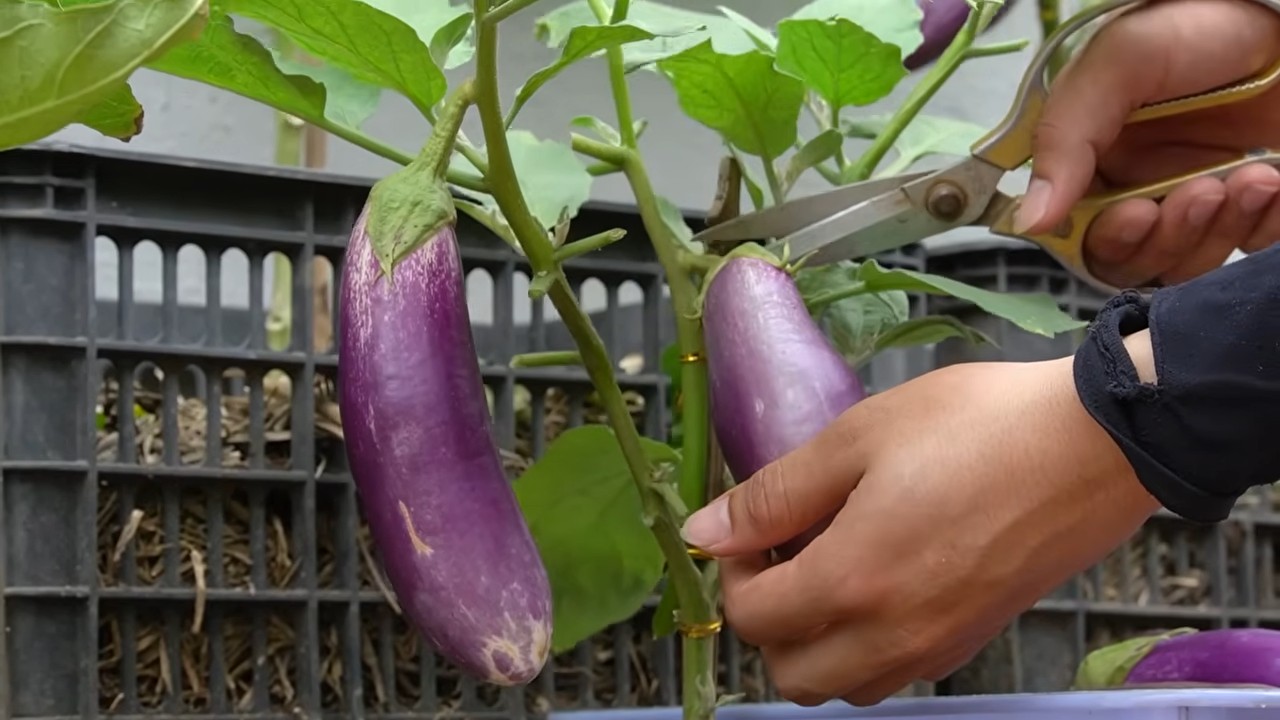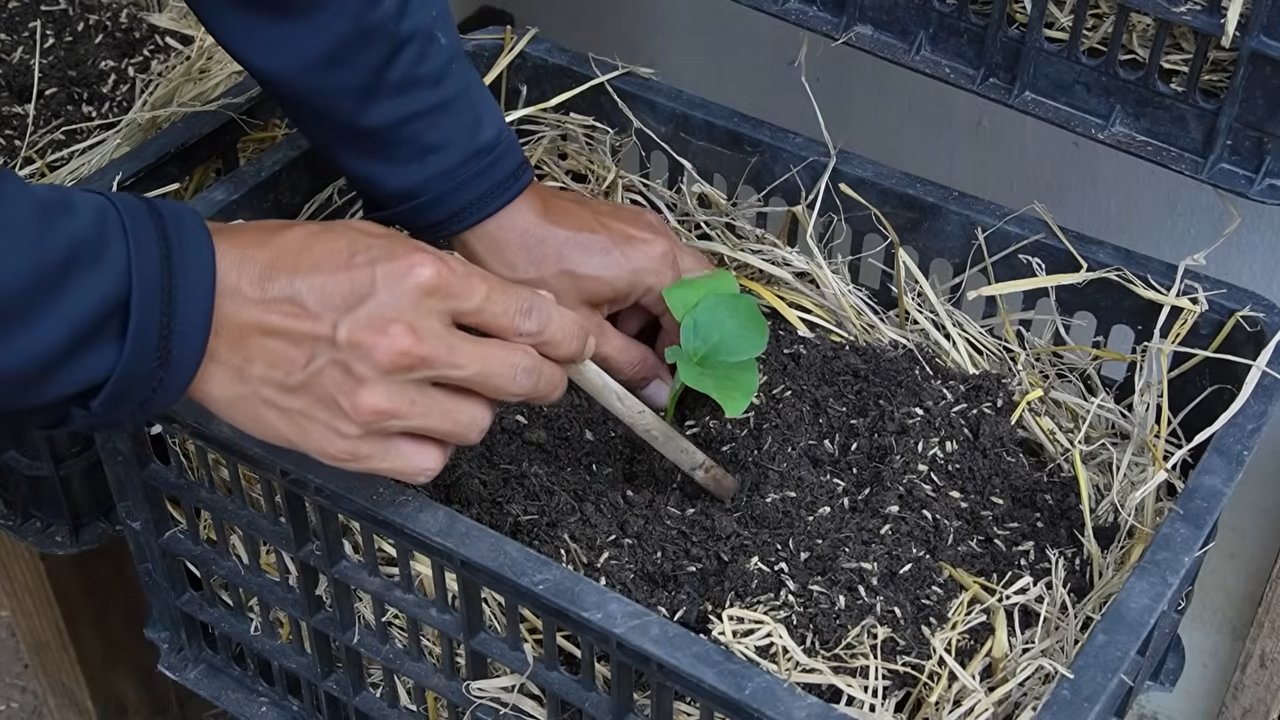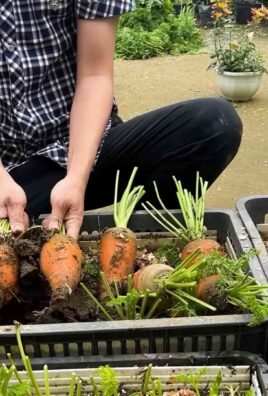Growing Eggplants Easily can seem daunting, but trust me, with a few clever tricks and DIY hacks, you’ll be harvesting these glossy beauties in no time! Forget those expensive grocery store eggplants – imagine stepping into your own backyard and picking fresh, flavorful eggplants for your favorite dishes.
Eggplants have a rich history, dating back thousands of years to ancient Asia, where they were cultivated for both culinary and medicinal purposes. Over centuries, they’ve journeyed across continents, becoming a staple in cuisines worldwide, from Italian parmigiana to Middle Eastern baba ghanoush. But you don’t need to be a seasoned gardener to enjoy the fruits (or rather, vegetables!) of your labor.
So, why do you need these DIY tricks for growing eggplants easily? Well, eggplants can be a bit finicky. They need the right conditions to thrive, and common gardening mistakes can lead to stunted growth, pest infestations, and ultimately, a disappointing harvest. But don’t worry! I’m here to share my tried-and-true methods, simple DIY solutions, and insider tips that will transform your eggplant-growing experience. Get ready to unlock the secrets to a bountiful eggplant harvest, even if you’re a complete beginner!

Growing Eggplants Made Easy: Your DIY Guide for a Bountiful Harvest
I love eggplants! Their rich flavor and versatility in the kitchen make them one of my favorite vegetables. But instead of always buying them at the supermarket, I decided to grow them myself. And I can tell you, it’s not as hard as you might think! With this DIY guide, I’ll show you how you can achieve a rich eggplant harvest even without a green thumb.
What You Need: The Preparation
Before we get started, let’s make sure we have everything we need. Here is a list of the materials and tools you’ll need for growing eggplants:
- Eggplant seeds or young plants: You can either start with seeds or make the process easier and buy young plants. I recommend starting with young plants, especially if you have little experience.
- Seed starting mix: Special seed starting mix is low in nutrients and loose, ideal for seed germination and the growth of young plants.
- Seedling pots or trays: Small pots or trays in which you can start the seeds indoors.
- Larger pots or a garden bed: As the plants get bigger, they will need more space.
- Garden soil: High-quality garden soil, enriched with compost or organic fertilizer.
- Compost or organic fertilizer: To provide the plants with enough nutrients.
- Watering can or garden hose: For regular watering.
- Plant stakes: To support the plants as they grow larger and bear fruit.
- Pruning shears: For removing side shoots and harvesting the eggplants.
- Mulch material (e.g., straw or wood chips): To keep the soil moist and suppress weeds.
- A sunny location: Eggplants love the sun!
Sowing and Starting Indoors: The Start of the Eggplant Season
If you have decided on seeds, you will need to start the eggplants indoors. This is important because eggplants have a long growing season and cannot be sown directly outdoors in our latitudes.
- Sow seeds: Fill the seedling pots with seed starting mix. Place 2-3 seeds per pot on the soil and cover them lightly with soil (approx. 0.5 cm).
- Water: Moisten the soil gently with a spray bottle or watering can. The soil should be moist, but not wet.
- Keep warm: Place the seedling pots in a warm and bright place. The ideal germination temperature is 22-25°C. A mini-greenhouse or a windowsill above a heater is ideal.
- Maintain moisture: Keep the soil evenly moist. You can cover the pots with plastic wrap to increase humidity. But don’t forget to ventilate the plastic wrap regularly to prevent mold.
- Pricking out: As soon as the seedlings have 2-3 true leaves (besides the initial seed leaves), you can prick them out. This means you transplant each seedling individually into a larger pot with seed starting mix. Choose the strongest seedling per pot and remove the others.
Transplanting into the Garden or Larger Pots: The Next Step
Once the eggplant plants are large enough and the temperatures rise, they can be transplanted into the garden or larger pots.
- Hardening off: Before you plant the plants outdoors, you should harden them off. This means you place them outdoors during the day for a few days to get them used to the sun and cooler temperatures. Start with a few hours and increase the time each day.
- Prepare the location: Choose a sunny location with well-drained soil. Loosen the soil and mix in compost or organic fertilizer.
- Planting: Dig a hole large enough to accommodate the root ball of the eggplant plant. Carefully place the plant in the hole and fill it with soil. Press the soil down lightly. Make sure the root ball is completely covered with soil.
- Watering: Water the plants thoroughly after planting.
- Planting distance: Ensure sufficient spacing between plants. Eggplant plants need space to develop. A distance of 45-60 cm between plants and 75-90 cm between rows is ideal.
- Staking: Place a plant stake next to each plant to support it as it grows larger and bears fruit.
Caring for Eggplant Plants: Keeping Them Happy
Eggplants are relatively easy to care for, but you should keep a few things in mind to achieve a bountiful harvest.
- Watering: Eggplants need regular water, especially during the flowering and fruiting period. It’s best to water the plants in the morning so the leaves can dry during the day. Avoid waterlogging.
- Fertilizing: Fertilize the eggplant plants regularly with an organic fertilizer or compost. Start about 2-3 weeks after planting and repeat the fertilization every 2-3 weeks.
- Mulching: Cover the soil around the plants with mulch material like straw or wood chips. This keeps the soil moist, suppresses weeds, and protects the fruit from direct contact with the ground.
- Removing side shoots: Regularly remove the side shoots that form in the leaf axils. This promotes the formation of larger and more mature fruits. Leave only the main stem and a few side shoots.
- Pests and diseases: Watch out for pests like aphids, Colorado potato beetles, and spider mites. In case of infestation, you can use natural pesticides like neem oil or a soap solution. Eggplants can also be affected by fungal diseases like powdery mildew. Ensure good ventilation and avoid waterlogging to prevent diseases.
Harvest Time: The Fruits of Your Labor
The harvest time for eggplants usually begins in July or August, depending on the variety and weather conditions.
- Recognizing ripeness: Eggplants are ripe when they have a shiny, plump skin and yield slightly to pressure. The color should be intense, depending on the variety, dark purple, white, or green.
- Harvesting: Cut the eggplants with pruning shears. Leave a small stem on the fruit.
- Harvest regularly: Harvest the eggplants regularly to encourage the formation of new fruits.
- Storage: Eggplants do not keep for long. Store them in the refrigerator and use them within a few days.
Additional Tips for a Successful Eggplant Harvest
Pollination: Eggplants are self-pollinating, but additional pollination by bees or other insects can improve the harvest. You can also gently shake the flowers to help with pollination
Choose the right variety: There are many different eggplant varieties that differ in size, color, and taste. Find out which varieties are best suited for your climate and preferences.
Pay attention to crop rotation: Do not plant eggplants in the same spot every year. Rotate the cultivation area to prevent diseases and pests.

Conclusion
So, there you have it! Growing eggplants easily doesn’t have to be a daunting task reserved for seasoned gardeners. With a little planning, the right techniques, and a dash of patience, you can cultivate a thriving eggplant patch right in your own backyard or even in containers on your balcony. This DIY approach not only saves you money compared to buying eggplants from the store, but it also gives you the satisfaction of knowing exactly where your food comes from and how it was grown.
The key takeaways are simple: start with quality seeds or seedlings, provide ample sunlight and warmth, ensure well-draining soil rich in nutrients, and consistently water and fertilize your plants. Don’t forget the importance of staking or caging your eggplants as they grow to support the heavy fruit and prevent them from toppling over. And remember to keep an eye out for common pests and diseases, addressing them promptly to protect your precious crop.
But the beauty of gardening lies in its adaptability. Feel free to experiment with different eggplant varieties to find your favorites. From the classic large, purple Globe eggplants to the slender, Asian-style varieties like Japanese eggplants or the vibrant, colorful Thai eggplants, there’s a whole world of flavors and textures to explore. You can also try different companion planting strategies to deter pests and attract beneficial insects. Basil, marigolds, and thyme are all excellent choices for planting alongside your eggplants.
Consider extending your growing season by starting your seeds indoors several weeks before the last expected frost. This will give your plants a head start and allow you to harvest eggplants earlier in the summer. If you live in a cooler climate, you can also use row covers or a greenhouse to protect your plants from frost and extend the growing season into the fall.
We’ve found that adding a layer of mulch around your eggplant plants can be incredibly beneficial. Mulch helps to retain moisture in the soil, suppress weeds, and regulate soil temperature. Organic mulches like straw, wood chips, or compost will also break down over time, adding valuable nutrients to the soil.
Ultimately, the best way to learn is by doing. So, don’t be afraid to get your hands dirty and give this DIY eggplant growing method a try. We’re confident that you’ll be rewarded with a bountiful harvest of delicious, homegrown eggplants that you can use in all sorts of culinary creations.
We encourage you to share your experiences with us! Let us know what varieties you’re growing, what challenges you’ve faced, and what successes you’ve achieved. Share your tips and tricks with fellow gardeners in the comments section below. Together, we can create a community of eggplant enthusiasts who are passionate about growing their own food. Happy gardening!
Frequently Asked Questions (FAQ)
What is the best time to start growing eggplants?
The ideal time to start growing eggplants depends on your climate. In warmer regions with long growing seasons, you can start seeds directly in the garden after the last frost. However, in cooler climates, it’s best to start seeds indoors 6-8 weeks before the last expected frost. This will give your plants a head start and allow you to harvest eggplants earlier in the summer. You can transplant the seedlings outdoors once the soil has warmed up and the risk of frost has passed. Aim for soil temperatures consistently above 60°F (15°C).
What kind of soil is best for growing eggplants?
Eggplants thrive in well-draining soil that is rich in organic matter. The ideal soil pH is between 6.0 and 7.0. Before planting, amend your soil with compost, aged manure, or other organic materials to improve its fertility and drainage. If your soil is heavy clay, consider adding sand or perlite to improve drainage. Raised beds or containers filled with a high-quality potting mix are also excellent options for growing eggplants, especially if your native soil is poor.
How much sunlight do eggplants need?
Eggplants require at least 6-8 hours of direct sunlight per day to produce a good crop of fruit. Choose a planting location that receives plenty of sunlight throughout the day. If you’re growing eggplants in containers, make sure to place them in a sunny spot. Insufficient sunlight can lead to leggy plants with poor fruit production.
How often should I water my eggplants?
Eggplants need consistent moisture to thrive. Water deeply and regularly, especially during hot, dry weather. Aim to keep the soil consistently moist but not waterlogged. A good rule of thumb is to water when the top inch of soil feels dry to the touch. Mulching around your plants can help to retain moisture in the soil and reduce the need for frequent watering. Avoid overhead watering, as this can increase the risk of fungal diseases. Instead, water at the base of the plants.
What are some common pests and diseases that affect eggplants?
Eggplants are susceptible to a variety of pests and diseases, including aphids, flea beetles, spider mites, tomato hornworms, and verticillium wilt. Regularly inspect your plants for signs of pests or diseases. If you find any, take action promptly to prevent them from spreading. Organic pest control methods, such as insecticidal soap or neem oil, can be effective for controlling many common pests. To prevent diseases, ensure good air circulation around your plants and avoid overhead watering. Crop rotation can also help to reduce the risk of soilborne diseases.
Do eggplants need to be staked or caged?
Yes, eggplants often need to be staked or caged, especially as they begin to produce fruit. The weight of the fruit can cause the plants to topple over, which can damage the stems and fruit. Staking or caging provides support for the plants and helps to keep the fruit off the ground. You can use bamboo stakes, tomato cages, or other sturdy supports to prop up your eggplants. Install the supports early in the growing season, before the plants become too large.
How do I know when my eggplants are ripe?
Eggplants are typically ready to harvest when they are firm, glossy, and have reached their mature size and color. The skin should be smooth and unblemished. Gently press the skin of the eggplant with your thumb. If it springs back, the eggplant is ripe. If it leaves a dent, it’s overripe. Use a sharp knife or pruning shears to cut the eggplant from the plant, leaving a short stem attached.
Can I grow eggplants in containers?
Yes, eggplants can be successfully grown in containers. Choose a large container that is at least 12 inches in diameter and depth. Make sure the container has drainage holes to prevent waterlogging. Fill the container with a high-quality potting mix. Select a compact or dwarf eggplant variety that is well-suited for container growing. Place the container in a sunny location that receives at least 6-8 hours of direct sunlight per day. Water and fertilize your container-grown eggplants regularly.
What are some good companion plants for eggplants?
Companion planting can be a great way to deter pests, attract beneficial insects, and improve the overall health of your eggplant plants. Some good companion plants for eggplants include basil, marigolds, thyme, rosemary, and peppers. Basil repels aphids and other pests, while marigolds attract beneficial insects like ladybugs and hoverflies. Thyme and rosemary also repel pests and attract pollinators. Peppers can help to deter flea beetles.
How can I improve the flavor of my homegrown eggplants?
To improve the flavor of your homegrown eggplants, harvest them when they are young and tender. Overripe eggplants can be bitter. Also, make sure to properly prepare your eggplants before cooking them. Salting the eggplant slices and letting them sit for 30 minutes can help to draw out excess moisture and reduce bitterness. Rinse the eggplant slices before cooking. You can also grill, roast, or bake your eggplants to enhance their flavor.




Leave a Comment